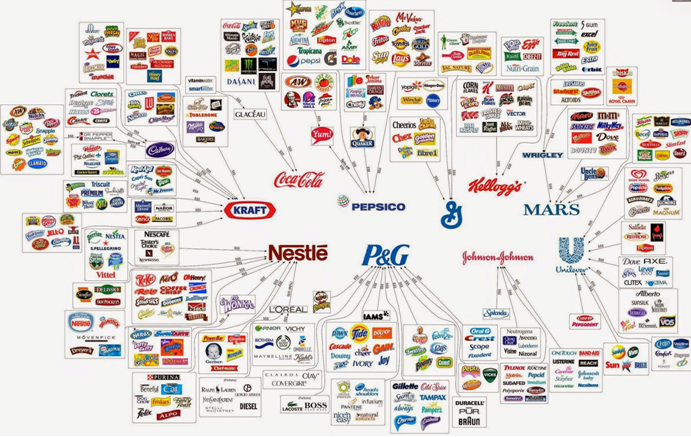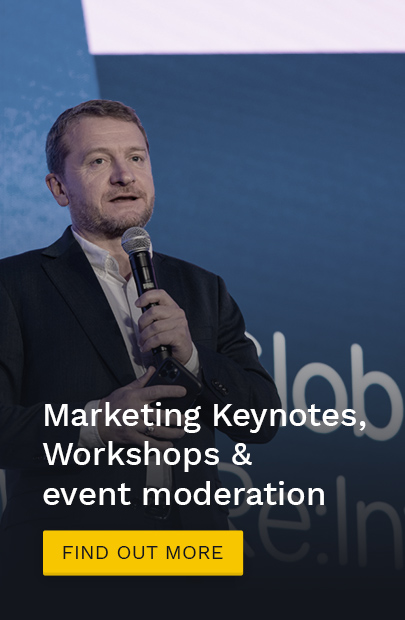Why the FMCG Big Brand are Trapped and What B2C Can Learn from B2B Brands
Working in consumer marketing is seen as the apex of the marketing career pyramid. Indeed, it is taken almost for granted that consumer marketing, and, in particular, FMCG marketing has the best brands, the best agencies and the best talent. So much so, that starting your career at P+G, Coca-Cola or Diageo can set up your career for the long term.
But is it time to rethink this idea, when we see so much great marketing being done outside of these FMCG royalty and, indeed, unconnected with consumer marketing? I’m tempted to ask the question: is the FMCG hegemony finally over?
Here is something you will never hear or read: what can consumer marketing learn from business to business marketing. B2B is often seen as the ugly stepsister of marketing. Not that sexy, not that interesting and certainly nothing to learn from.
Let’s see how true that really is: the dramatic effects of trends like cloud computing, managed services, the consumerisation of technology and the rise of ‘software-as-a-service'(SaaS) models has meant that the rules of the tech marketing game have changed. The outcome has meant that B2B customers don’t want to pay high prices out of “CapEx” budgets and now prefer lower “cloud” prices paid from “OpEx” budgets. The industry that has been dominated by the “pay first – consume later” principle is now transforming to a “pay as you consume” model. In other words, these B2B brands only get paid when and if they successfully the customer successfully consumes the business value of their product.
A Shift Has Begun in B2B: the Power is Now with the Customer
In other words, a shift has begun, and the risk is moving from the customer to the vendor. And, these vendors include some of the world’s biggest brands: Microsoft, Salesforce, and Amazon (through their AWS division). The SaaS business model eliminates the risk for the customer, and the vendor has to relentlessly create and deliver value all the time, otherwise, subscriptions fall off a cliff. Concepts such as the Lifetime Customer Value and Cost per Acquisition per Customer are these most important metrics because these are the lifeblood of a business. They have to think of customers not as buyers, but as future users where delivery of the proposition is directly connected to the success, and, indeed, the share price of the firm. These B2B brands have to continuously create value for the customer, otherwise its game over.
Compare that to my most recent experience with one of the UK’s most well-known mobile operator brands (a household name consumer brand): I had just switched over to their brand after my patience had run out after seventeen years of loyalty (yes, you read that right, SEVENTEEN years of loyalty) with another brand. No love after seventeen years, and tens of thousands, if not six figures of bills in that time, so I finally ‘churned’. Within one month, I rang the new carrier up to say that I wanted to pay them more money, that the contract I had originally signed was too low per month. I was told that I would have to pay out the next two years of the new contract before signing on for a new higher paying contract. Not a case of continuously creating value for the customer, more a case of extracting value from the customer.
There are signs of life that consumer marketing is slowly getting with the programme. A joint study by SAP, Siegel+Gale and Shift Thinking, based on 5,000 U.S. consumers, asked them about 50 different brands, both ‘traditional’ or ‘existing’ and ‘newer’ or ‘digital’ brands about perception, usage, preference and advocacy. They also mapped this to Net Promoter Scores (NPS) and marketing expenditures and strategies.
In this study, ‘traditional’ or ‘existing’ brands, such as Gillette and Coca-Cola, were rated higher on the statement ‘is a brand that people look up to’. In comparison, ‘newer’ or ‘digital’ rating higher on the statement ‘makes my life easier’ for brands such as Dollar Shave and Red Bull. Indeed, the research tried to make a distinction between what they called ‘Purchase Brands’, who focussed on creating demand to buy the product, emphasising promotion, while ‘Usage Brands’ focus on creating demand for the use of the product, and emphasised advocacy.
Whilst the distinction between ‘purchase’ and ‘usage’ might be a bit clunky and arbitrary, what is interesting is that emphasis of the ‘Usage Brands’ was around influencing how people experience the brand at every touchpoint. The example quoted was about how Apple Retail Stores that focus on the experience, instead of focusing on making a purchase. In other words, a ‘usage mentality’ means the customer is not seen as one-time buyers and more as a user with an ongoing relationship. And, survey respondents showed more loyalty, more preference and willingness to pay a premium for ‘Usage Brands’.
Of course, there are a lot of consumer ‘traditional’ or ‘existing’ brands that have to focus on usage, such as credit cards. But the qualitative difference for these newer, often digital brands is that they live and die on what happens after the purchase. Have a bad experience at a chain hotel? Too bad. Have a bad experience at an AirBnb? Not so good for the host!
SaaS: Building the Marketing into the Product’
What is interesting is how this maps to the world of B2B and, in particular, SaaS business propositions. In many B2B SaaS businesses, the brand and experience are one and the same. They even have a name for it in B2B: it’s called ‘building the marketing into the product’. Instead of making people want things, they have to make things people want. They have to focus on how their products will make a customer’s life better. Radical, eh? As a result, customer service and loyalty are changed from cost centres to being drivers of growth and profitability.
This shift is real, and I believe the B2B marketing mindset is now even more relevant for consumer brands. Microsoft, Amazon AWS, Salesforce and Oracle are literally betting their business on this usage model. They frame it within their business as ‘customer success’ and their share price is dependent on it. Their product’s consumption is guided by the priorities of their customers, so they have to deliver. A friend of mine from one of these top B2B tech brands tells that their compensation is tied to ensuring value is delivered to each customer.
So why do we still believe that P+G, Coca-Cola and Diageo are the oracles of marketing, when there so much evidence-based insights to show that there are a tonne of other ways to execute, deliver customer and shareholder value? Why is it this way and no other way? Legacy thinking and lazy thinking, in my opinion.
B2B marketing has really changed the mood music about what’s possible, and now it time for it to trickle back into consumer marketing. Dollar Shave Club turned the idea of buying a razor into a subscription business worth $1bn, and was bought by the definitive FMCG brand builder, Unilever. Now it’s time for consumer marketing to move on from one-off purchases or ‘gotcha’ moments – like when I signed up for my new mobile phone operator – position their brands to ensure ongoing renewal and advocacy. That’s when the FMCG hegemony might actually regain its position.




